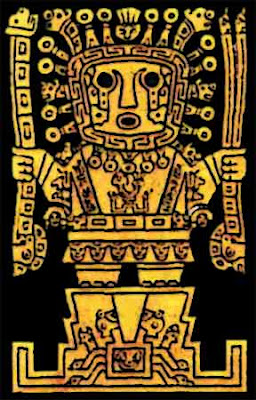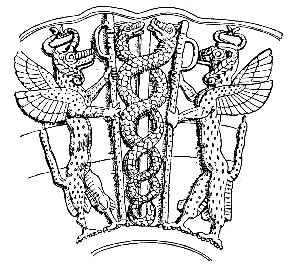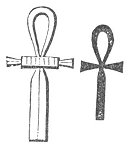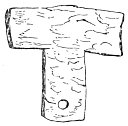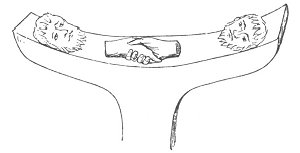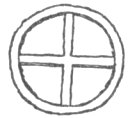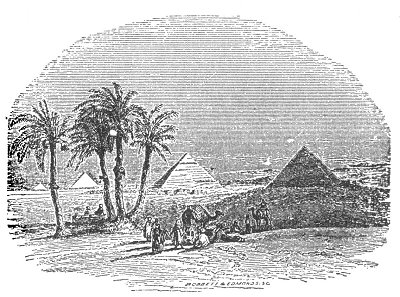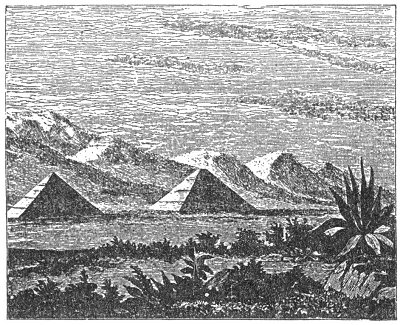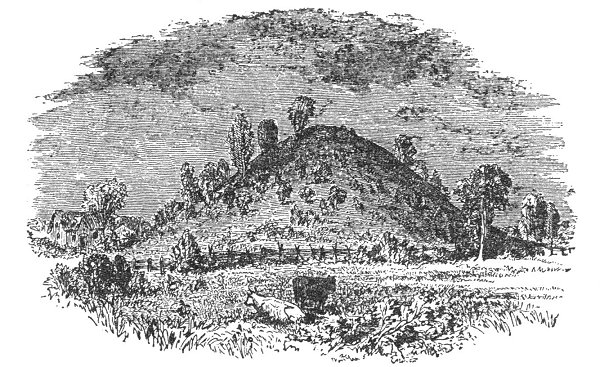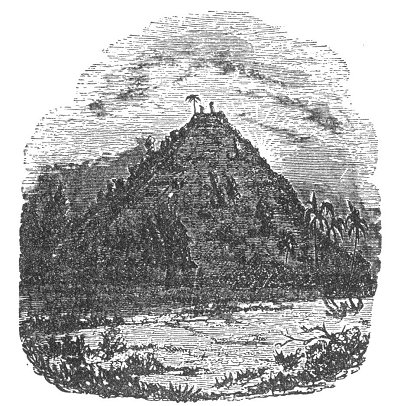Mayan cosmology including the (mushroom-referenced) Tree of Life functioning as the Axis Mundi/Mount Meru/Mount Atlas holding the sky up. This is a variation on the Atlantean world view, which represents a distinctive way of thinking in general according to Mindsteps to the Cosmos (This is the subject of a separate earlier blog but it is A) typical of the ancient empires such as the Ancient Egyptians and Babylonians, and also B ) introduced by the Capsian/Azilians during what Lewis spence called the last invasion of the Atlanteans, the Atlantis War of Plato about 9000 BC (Which can be independently verified as the introduction date for slings, bows and arrows and the whole military technology that went with the package, according to Feril in Origins of War.)
This is also the Biblical representation, and it happens that other cultures that no longer actually identified with the whole conception continued to place Atlants as Edin as the Omphalos or "Navel of the World"-in other words, they might have gotten away from the Atlantean conception that held Atlantis to be primary over all the rest of the Earth, but they still continued the same representations of it as such, especially on such things as their world maps. This is one of the clues that the Maps of the Ancient Sea Kings, or a significant section of them which is the part that was passed down to us, had an Atlantean origin and reflected the Atlantean point of view during the last days of the Ice Age
![]()
Antique map of the Garden of Eden, from a website dealing in antique maps. The "Cross of waters" ("Rivers which ran to the four directions") is a part of this. A little reflection should have shown that rivers running from one central mountain and to the four directions is hydrologically very improbable, yet all traditions which preserve the Atlantean point of view insist on it. The most elaborately developed versions of these rivers of Paradise specified that they were made up of water and milk, honey and wine. All of these are vehicles by which the potent and distasteful Amanita muscaria mushrooms may be diluted and washed down more easily. The Bible names the four rivers as the Nile, Ganges, Tigris and Euphrates, which cannot have a single source in the real world as we understand these rivers to be. And Plato's Atlantis dialogues also includes the Cross f Waters to the four directions in a couple of different variations, and including the City of Atlantis and the more elaborated Great Plain of Atlantis which was covered by criss-cross canals. Ironically it is the description of Plato's Atlantis that makes sense of the description and not the others. This is one of the reasons that Plato's description meant a real place whereas most of the other versions remembered it as more of a fairyland or otherworldly location.
![]()
Aligning the "East" or "Front" direction on the Eden tradition to the true East it immediately becomes obvious that "Eastward in Eden" became the source of settlements
"Eastward FROM Eden" on the way to Palestine. Donnelly explains the story of Genesis that way and the Caanaanite traditions od Ras Shamra (Ugarit) also specify it this way. In these traditions, Paradise is at the edge of the Great Abyss (= the open ocean outside the Mediterranean, this can be understood as standing by the Abyssal plain, on the farther or opposing shore) at the place where the sun goes down in the Far West and where "Heaven Meets Earth," Which corresponds to the Egyptian conception of the "Land of the dead" also and means a very specific geographic location as working backward from Egypt, Greece and the Holy Lands. The distance from Palestine to this area in Caananite and Phoenician tradition is given vaguely in an undetermined unit of measure, but it can be read as 2000 to 3000 miles by our terms, meaning the full span of the Mediterranean sea, actually. ((Part of the problem with this is another contentious figure read as 10,000 sometimes and 1,000 at others by different experts- which is exactly the same problem in interpreting the Egyptian texts as meaning 1/10 the given figures according to the "Belittlers" of Plato's Egyptian Atlantis story)
At any rate the only possible reading of the clues is that it is in the Atlantic Ocean facing the Pillars of Hercules/Straits of Gibraltar, the
KHUT or Mountain of Sunset, with its own corresponding "Gatekeepers" on the other side. (Compare Sumerian
Kur, the "land of the living" or mountain, as a feature of the Sumerian Paradise, and the various "Serpent Goddesses which would represent Venus associated with a pair of snakes) And this is also a Venus tradition because the two "Gatekeepers" are also traditionally identified with Venus (Hesperus or The Evening Star, In the Far West, and the land thus known as the Garden of the Hesperides in Greek tradition because of it. This is also very exact)
![]() |
The Venus Twins in Mexico, one is Quetzalcoatl. Both of these "Gatekeepers of the sun"
are represented as snakes in other areas. In the Orient, one of them would be Ganesha. |
a
![]()
Sun gate at Tiawanaco, the Gatekeepers are twin snakes that seem like stiff posts. The twin posts station at the doors of temples in many places were identified with the planet Venus.
Sumerian Gatekeeper dragons and Cadyseus.
![]() |
maya tree of life, Cadyseus pillar marked with concentric city circles,
Mayan Land of the Dead (Xibalba) |
http://en.wikipedia.org/wiki/Garden_of_the_gods_(Sumerian_paradise)http://en.wikipedia.org/wiki/Paradisehttp://en.wikipedia.org/wiki/Garden_of_Edenhttp://www.sacred-texts.com/atl/ataw/ataw405.htm
Atlantis the Antediluvian Empire by Ignatius Donnelly, 1882, THE Classic of the Field:
CHAPTER V.
THE PYRAMID, THE CROSS, AND THE GARDEN OF EDEN.
No fact is better established than the reverence shown to the sign of the Cross in all the ages prior to Christianity. We cannot do better than quote from an able article in the Edinburgh Review of July, 1870, upon this question:
"From the dawn of organized Paganism in the Eastern world to the final establishment of Christianity in the Western, the Cross was undoubtedly one of the commonest and most sacred of symbolical monuments; and, to a remarkable extent, it is so still in almost every land where that of Calvary is unrecognized or unknown. Apart from any distinctions of social or intellectual superiority, of caste, color, nationality, or location in either hemisphere, it appears to have been the aboriginal possession of every people in antiquity--the elastic girdle, so to say, which embraced the most widely separated heathen communities--the most significant token of a universal brotherhood, to which all the families of mankind were severally and irresistibly drawn, and by which
their common descent was emphatically expressed, or by means of which each and all preserved, amid every vicissitude of fortune, a knowledge of
the primeval happiness and dignity of their species. Where authentic history is silent on the subject, the material relics of past and long since forgotten races are not wanting to confirm and strengthen this supposition. Diversified forms of the symbol are delineated more or less artistically, according to the progress achieved in civilization at the period, on the ruined walls of temples and palaces, on natural rocks and sepulchral galleries, on the hoariest monoliths and the rudest statuary; on coins, medals, and vases of every description; and, in not a few instances, are preserved in the architectural proportions of subterranean
p. 318as well as superterranean structures, of tumuli as well as fanes. The extraordinary sanctity attaching to the symbol, in every age and under every variety of circumstance, justified any expenditure incurred in its fabrication or embellishment; hence the most persistent labor, the most consummate ingenuity, were lavished upon it. Populations of essentially different culture, tastes, and pursuits--the highly-civilized and the demi-civilized, the settled and nomadic--vied with each other in their efforts to extend the knowledge of its exceptional import and virtue among their latest posterities. The marvellous rock-hewn caves of Elephanta and Ellora, and the stately temples of Mathura and Terputty, in the East, may be cited as characteristic examples of one laborious method of exhibiting it; and the megalithic structures of Callernish and Newgrange, in the West, of another; while a third may be instanced. in the great temple at Mitzla, 'the City of the Moon,' in Ojaaca, Central America. also excavated in the living rock, and manifesting the same stupendous labor and ingenuity as are observable in the cognate caverns of Salsette--of endeavors, we repeat, made by peoples as intellectually as geographically distinct, and followers withal of independent and unassociated deities, to magnify and perpetuate some grand primeval symbol. . . .
"Of the several varieties of the Cross still in vogue, as national or ecclesiastical emblems, in this and other European states, and distinguished by the familiar appellations of St. George, St. Andrew, the Maltese, the Greek, the Latin, etc., etc., there is not one among them the existence of which may not be traced to the remotest antiquity. They were the common property of the Eastern nations. No revolution or other casualty has wrought any perceptible difference in their several forms or delineations; they have passed from one hemisphere to the other intact; have survived dynasties, empires, and races; have been borne on the crest of each successive wave of Aryan population in its course toward the West; and, having been reconsecrated in later times by their lineal descendants, are still recognized as military and national badges of distinction. . . .
"Among the earliest known types is the
crux ansata, vulgarly called 'the key of the Nile,' because of its being found sculptured or otherwise represented so frequently upon Egyptian and Coptic monuments. It has, however, a very much older and more sacred signification than this. It was the symbol of
p. 319symbols, the mystical Tau, 'the bidden wisdom,' not only of the ancient Egyptians but also of the Chaldeans, Phœnicians, Mexicans, Peruvians, and of every other ancient people commemorated in history, in either hemisphere, and is formed very similarly to our letter
T, with a roundlet, or oval, placed immediately above it. Thus it was figured
![EGYPTIAN TAU.]()
EGYPTIAN TAU. |
on the gigantic emerald or glass statue of Serapis, which was transported (293 B.C.) by order of Ptolemy Soter from Sinope, on the southern shores of the Black Sea, re-erected within that famous labyrinth which encompassed the banks of Lake Mœris, and destroyed by the victorious army of Theodosius (A.D. 389), despite the earnest entreaties of the Egyptian priesthood to spare it, because it was the emblem of their god and of 'the life to come.' Sometimes, as may be seen on the breast of an Egyptian mummy in the museum of the London University, the simple
T only is planted on the frustum of a cone; and sometimes it is represented as springing from a heart; in the first instance signifying goodness; in the second, hope or expectation of reward. As in the oldest temples
![CROSS ROM THE MONUMENTS OF PALENQUE.]()
CROSS ROM THE MONUMENTS OF PALENQUE. |
and catacombs of Egypt, so this type likewise abounds in the ruined cities of Mexico and Central America, graven as well upon the most ancient cyclopean and polygonal walls as upon the more modern and perfect examples of masonry; and is displayed in an equally conspicuous manner upon the breasts of innumerable bronze statuettes which have been recently disinterred from the cemetery of Juigalpa (of unknown antiquity) in Nicaragua."
When the Spanish missionaries first set foot upon the soil of America, in the fifteenth century, they were amazed to find the Cross was as devoutly worshipped by the red Indians as by themselves, and were in doubt whether to ascribe the fact to the pious labors of St. Thomas or to the cunning device of the Evil One. The hallowed symbol challenged their attention
p. 320![ANCIENT IRISH CROSS.]()
ANCIENT IRISH CROSS. |
on every hand and in almost every variety of form. It appeared on the bass-reliefs of ruined and deserted as well as on those of inhabited palaces, and was the most conspicuous ornament in the great temple of Gozumel, off the coast of Yucatan. According to the particular locality, and the purpose which it served, it was formed of various materials--of marble and gypsum in the open spaces of cities and by the way-side; of wood in the teocallis or chapels on pyramidal summits and in subterranean sanctuaries; and of emerald or jasper in the palaces of kings and nobles.
When we ask the question how it comes that the sign of the Cross has thus been reverenced. from the highest antiquity by the races of the Old and New Worlds, we learn
![CENTRAL AMERICAN CROSS]()
CENTRAL AMERICAN CROSS |
that it is a reminiscence of the Garden of Eden, in other words, of Atlantis.
Professor Hardwicke says:
"All these and similar traditions are but mocking satires of the old Hebrew story--jarred and broken notes of the same strain; but with all their exaggerations they intimate how in the background of man's vision lay a paradise of holy joy--a paradise secured from every kind of profanation, and made
![COPPER COIN--TEOTIHUACAN.]()
COPPER COIN--TEOTIHUACAN. |
inaccessible to the guilty; a paradise full of objects that were calculated to delight the senses and to elevate the mind a paradise that granted to its tenant rich and rare immunities, and that fed with its perennial streams the tree of life and immortality."
To quote again from the writer in the
Edinburgh Review, already cited:
p. 321"Its undoubted antiquity, no less than its extraordinary diffusion, evidences that it must have been, as it may be said to be still in unchristianized lands, emblematical of some fundamental doctrine or mystery. The reader will not have failed to observe that it is most usually associated with water; it was 'the key of the Nile,' that mystical instrument by means of which, in the popular judgment of his Egyptian devotees, Osiris produced the annual revivifying inundations of the sacred stream; it is discernible in that mysterious pitcher or vase portrayed on the brazen table of Bembus, before-mentioned, with its four lips discharging as many streams of water in opposite directions; it was the emblem of the water-deities of the Babylonians in the East and of the Gothic nations in the West, a
![]()
ANCIENT IRISH CROSS--PRE-CHRISTIAN--KILNABOY.
well as that of the rain-deities respectively of the mixed population in America. We have seen with what peculiar rites the symbol was honored by those widely separated races in the western hemisphere; and the monumental slabs of Nineveh, now in the museums of London and Paris, show us how it was similarly honored by the successors of the Chaldees in the eastern. . . .
"In Egypt, Assyria, and Britain it was emblematical of creative power and eternity; in India, China, and Scandinavia, of heaven and immortality; in the two Americas, of rejuvenescence and freedom from physical suffering; while in both hemispheres it was the common symbol of the resurrection, or 'the sign of the life to come;' and, finally, in all heathen communities,
p. 322without exception, it was the emphatic type, the sole enduring evidence, of the Divine Unity. This circumstance alone determines its extreme antiquity--an antiquity, in all likelihood, long antecedent to the foundation of either of the three great systems of religion in the East. And, lastly, we have seen how, as a rule, it is found in conjunction with a stream or streams of water, with exuberant vegetation, and with a bill or a mountainous region--in a word,
with a land of beauty, fertility, and joy. Thus it was expressed upon those circular and sacred cakes of the Egyptians, composed of the richest materials-of flour, of honey, of milk--and with which the serpent
![CROSS FROM EGYPTIAN MONUMENTS.]()
CROSS FROM EGYPTIAN MONUMENTS. |
and bull, as well as other reptiles and beasts consecrated to the service of Isis and their higher divinities, were daily fed; and upon certain festivals were eaten with extraordinary ceremony by the people and their priests. 'The cross-cake,' says Sir Gardner Wilkinson, 'was their hieroglyph for civilized land;' obviously
a land superior to their own, as it was, indeed, to all other mundane territories; for it was that
distant, traditional country of sempiternal contentment and repose, of exquisite delight and serenity, where Nature, unassisted by man, produces all that is necessary for his sustentation."
And this land was the Garden of Eden of our race. This was the Olympus of the Greeks, where
"This same mild season gives the blooms to blow,
The buds to harden and the fruits to grow."In the midst of it was a sacred and glorious eminence [or Omphalos]--the
umbilicus orbis terrarum--"toward which the heathen in all parts of the world, and in all ages, turned a wistful gaze in every act of devotion, and to which they hoped to be admitted, or, rather, to be restored, at the close of this transitory scene."
In this "glorious eminence" do we not see Plato's mountain in the middle of Atlantis, as he describes it:
"Near the plain and in the centre of the island there was a mountain, not very high on any side. In this mountain there dwelt one of the earth-born primeval men of that country,
p. 323whose name was Evenor, and he had a wife named Leucippe, and they had an only daughter, who was named Cleito. Poseidon married her. He enclosed the hill in which she dwelt all around, making alternate zones of sea and land, larger and smaller, encircling one another; there were two of land and three of water . . . so that no man could get to the island. . . . He brought streams of water under the earth to this mountain-island, and made all manner of food to grow upon it. This island became the seat of Atlas, the over-king of the whole island; upon it they built the great temple of their nation; they continued to ornament it in successive generations, every king surpassing the one who came before him to the utmost of his power, until they made the building a marvel to behold for size and beauty. . . . And they had such an amount of wealth as was never before possessed by kings and potentates--as is not likely ever to be again."
The gardens of Alcinous and Laertes, of which we read in Homeric song, and those of Babylon, were probably transcripts of Atlantis. "The sacred eminence in the midst of a 'superabundant, happy region figures more or less distinctly in a]most every mythology, ancient or modern. It was the Mesomphalos of the earlier Greeks, and the Omphalium of the Cretans, dominating the Elysian fields, upon whose tops, bathed in pure, brilliant, incomparable light, the gods passed their days in ceaseless joys."
"The Buddhists and Brahmans, who together constitute nearly half the population of the world, tell us that the decussated figure (the cross), whether in a simple or a complex form, symbolizes the traditional happy abode of their primeval ancestors--that 'Paradise of Eden toward the East,' as we find expressed in the Hebrew. And, let us ask, what better picture, or more significant characters, in the complicated alphabet of symbolism, could have been selected for the purpose than a circle and a cross: the one to denote a region of absolute purity and perpetual felicity; the other, those four perennial streams that divided and watered the several quarters of it?" (
Edinburgh Review, January, 1870.)
And when we turn to the mythology of the Greeks, we find
p. 324that the origin of the world was ascribed to
Okeanos, the ocean, The world was at first an island surrounded by the ocean, as by a great stream:
"It was a region of wonders of all kinds; Okeanos lived there with his wife Tethys: these were the Islands of the Blessed, the gardens of the gods, the sources of nectar and ambrosia, on which the gods lived. Within this
circle of water the earth lay spread out like a disk,
with mountains rising from it, and the vault of heaven appearing to rest upon its outer edge all around." (Murray's "Manual of Mythology," pp. 23, 24,
et seq.)
On the mountains dwelt the gods; they had palaces on these mountains, with store-rooms, stabling, etc.
"The Gardens of the Hesperides, with their golden apples, were believed to exist i
n some island of the ocean, or, as it was sometimes thought,
in the islands off the north or
west coast of Africa. They were far famed in antiquity; for it was there that springs of nectar flowed by the couch of Zeus, and there that the earth displayed the rarest blessings of the gods; it was another Eden." (
Ibid., p. 156.)
Homer described it in these words:
"Stern winter smiles on that auspicious clime,
The fields are florid with unfading prime,
From the bleak pole no winds inclement blow.
Mould the round hail, or flake the fleecy snow;
But from the breezy deep the blessed inhale
The fragrant murmurs of the western gale.""It was the sacred Asgard of the Scandinavians, springing from the centre of a fruitful land, which was watered by
four primeval rivers of milk, severally flowing in the direction of the cardinal points, 'the abode of happiness, and the height of bliss.' It is the Tien-Chan, 'the celestial mountain-land, . . . the enchanted gardens' of the Chinese and Tartars, watered by the four perennial fountains of Tychin, or Immortality; it is the hill-encompassed Ilá of the Singhalese and Thibetians, 'the everlasting dwelling-place of the wise and just.' It is the Sineru of the Buddhist, on the summit of which is Tawrutisa, the habitation of Sekrá, the supreme god, from which proceed the
four sacred streams, running in as many contrary directions.
p. 325[paragraph continues] It is the Slávratta, 'the celestial earth,' of the Hindoo, the summit of his golden mountain
Meru, the city of Brahma, in the centre of Jamba
dwípa, and from the four sides of which gush forth the
four primeval rivers, reflecting in their passage the colorific glories of their source, and severally flowing northward, southward, eastward, and westward."
It is the Garden of Eden of the Hebrews:
"And the Lord God planted a garden eastward in Eden; and there he put the man whom he had formed. And out of the ground made the Lord God to grow every tree that is pleasant to the sight, and good for food; the tree of life also in the midst of the garden, and the tree of knowledge of good and evil. And a river went out of Eden to water the garden; and from thence it was parted, and became into
four heads. The name of the first is Pison; that is it which compasseth the whole land of Havilah, where there is gold; and the gold of that land is good: there is bdellium and the onyx stone. And the name of the second river is Gihon: the same is it that compasseth the whole land of Ethiopia. And the name of the third river is Hiddekel: that is it which goeth toward the east of Assyria. And the fourth river is Euphrates. And the Lord God took the man and put him into the Garden of Eden to dress it and to keep it." (Gen. ii., 8-1-5.)
As the four rivers named in Genesis are not branches of any one stream, and head in very different regions, it is evident that there was an attempt, on the part of the writer of the Book, to adapt an ancient tradition concerning another country to the known features of the region in which be dwelt.
Josephus tells us (chap. i., p. 41), "Now the garden (of Eden) was watered by one river,
which ran round about the whole earth, and was parted into four parts." Here in the four parts we see the origin of the Cross, while in the river running around the whole earth we have the wonderful canal of Atlantis, described by Plato, which was "carried around the whole of the plain," and received the streams which came down from the mountains. The streams named by Josephus would seem to represent the migrations of people from Atlantis to its colonies.
p. 356[paragraph continues] "Phison," he tells us, "denotes a multitude; it ran into India; the Euphrates and Tigris go down into the Red Sea while the Geon runs through Egypt."
We are further told (chap. ii., p. 42) that when Cain, after the murder of. Abel, left the land of Adam, "he travelled over many countries" before be reached the land of Nod;
and the land of Nod was to the eastward of Adam's home. In other words, the original seat of mankind was in the West, that is to say, in the direction of Atlantis. Wilson tells us that the Aryans of India believed that they originally came "from the West." Thus the nations on the west of the Atlantic look to the
east for their place of origin; while on the east of the Atlantic they look to the
west: thus all the lines of tradition converge upon Atlantis.
But here is the same testimony that in the Garden of Eden there were four rivers radiating from one parent stream. And these four rivers, as we have seen, we find in the Scandinavian traditions, and in the legends of the Chinese, the Tartars, the Singhalese, the Thibetians, the Buddhists, the Hebrews, and the Brahmans.
And not only do we find this tradition of the Garden of Eden in the Old World, but it meets us also among the civilized races of America. The elder Montezuma said to Cortez, "Our fathers dwelt in that happy and prosperous place which they called Aztlan, which means
whiteness. . . . In this place
there is a great mountain in the middle of the water which is called Culhuacan, because it has the point somewhat turned over toward the bottom; and for this cause it is called Culhuacan, which means 'crooked mountain.'" He then proceeds to describe the charms of this favored land, abounding in birds, game, fish, trees, "fountains enclosed with elders and junipers, and alder-trees both large and beautiful." The people planted "maize, red peppers, tomatoes, beans, and all kinds of plants,
in furrows."
Here we have the same mountain in the midst of the water
p. 327which Plato describes--the same mountain to which all the legends of the most ancient races of Europe refer.
The inhabitants of Aztlan were
boatmen. (Bancroft's "Native Races," vol. v., p. 325.) E. G. Squier, in his "Notes on Central America," p. 349, says, "It is a significant fact that in the map of their migrations, presented by Gemelli, the place of the origin of the Aztecs is designated by the sign of water,
Atl standing for
Atzlan, a
pyramidal temple with grades, and near these a palm-tree." This circumstance did not escape the attention of Humboldt, who says, I am astonished at finding a palm-tree near this teocalli. This tree certainly does not indicate a northern origin. . . . The possibility that an unskilful artist should unintentionally represent a tree of which he had no knowledge is so great, that any argument dependent on it hangs upon a slender thread." ("North Americans of Antiquity," p. 266.)
The Miztecs, a tribe dwelling on the outskirts of Mexico, had a tradition that the gods, "in the day of obscurity and darkness," built "a sumptuous palace, a masterpiece of skill, in which they male their abode upon a mountain. The rock was called 'The Place of Heaven;' there the gods first abode on earth, living many years in great rest and content, as in a happy and delicious land, though the world still lay in obscurity and darkness. The children of these gods made to themselves a garden, in which they put many trees, and fruit-trees, and flowers, and roses, and odorous herbs. Subsequently there came a great deluge, in which many of the sons and daughters of the gods perished." (Bancroft's "Native Races," vol. iii., p. 71.) Here we have a distinct reference to Olympus, the Garden of Plato, and the destruction of Atlantis.
And in Plato's account of Atlantis we have another description of the Garden of Eden and the Golden Age of the world:
"Also, whatever fragrant things there are in the earth, whether roots, or herbage, or woods, or distilling drops of flowers and fruits, grew and thrived in that land; and again the cultivated
p. 328fruits of the earth, both the edible fruits and other species of food which we call by the name of legumes, and the fruits having a hard rind, affording drinks and meats and ointments . . . all these that sacred island, lying beneath the sun, brought forth in abundance. . . . For many generations, as long as the divine nature lasted in them, they were obedient to the laws, and well affectioned toward the gods, who were their kinsmen; for they possessed true and in every way great spirits, practising gentleness and wisdom in the various chances of life, and in their intercourse with one another. They despised everything but virtue, not caring for their present state of life, and thinking lightly of the possession of gold and other property, which seemed only a burden to them; neither were they intoxicated by luxury; nor did wealth deprive them of their self-control; but they were sober, and saw clearly that all these goods were increased by virtuous friendship with one another, and that by excessive zeal for them, and honor of them, the good of them is lost, and friendship perishes with them."
All this cannot be a mere coincidence; it points to a common tradition of a veritable land, where four rivers flowed down in opposite directions from a central mountain-peak. And these four rivers, flowing to the north, south, east, and west, constitute the origin of that sign of the Cross which we have seen meeting us at every point among the races who were either descended from the people of Atlantis, or who, by commerce and colonization, received their opinions and civilization from them.
Let us look at the question of the identity of the Garden of Eden with Atlantis from another point of view:
If the alphabet of the Phœnicians is kindred with the Maya alphabet, as I think is clear, then the Phœnicians were of the same race, or of some race with which the Mayas were connected; in other words, they were from Atlantis.
Now we know that the Phœnicians and Hebrews were of the same stock, used the same alphabet, and spoke almost precisely the same language.
The Phœnicians preserved traditions, which have come down
p. 329to us in the writings, of Sanchoniathon, of all the great essential inventions or discoveries which underlie civilization. The first two human beings, they tell us, were Protogonos and Aion (Adam and 'Havath), who produce Genos and Genea (Qên and Qênath), from whom again are descended three brothers, named Phos, Phur, and Phlox (Light, Fire, and Flame), because they "have discovered how to produce fire by the friction of two pieces of wood, and have taught the use of this element." In another fragment, at the origin of the human race we see in succession the fraternal couples of Autochthon and Technites (Adam and Quen--Cain?), inventors of the manufacture of bricks; Agros and Agrotes (Sade and Cêd), fathers of the agriculturists and hunters; then Amynos and Magos, "who taught to dwell in villages and rear flocks."
The connection between these Atlantean traditions and the Bible record is shown in many things. For instance, "the Greek text, in expressing the invention of Amynos, uses the words κώμας καὶ ποίμνας, which are precisely the same as the terms
ôhel umiqneh, which the Bible uses in speaking of the dwellings of the descendants of Jabal (Gen., chap. iv., v. 20). In like manner Lamech, both in the signification of his name and also iv the savage character attributed to him by the legend attached to his memory, is a true synonyme of Agrotes."
"And the title of Ἀλῆται, given to Agros and Agrotes in the Greek of the Phœnician history, fits in wonderfully with the physiognomy of the race of the Cainites in the Bible narrative, whether we take Ἀλῆται simply as a Hellenized transcription of the Semitic
Elim, 'the strong, the mighty,' or whether we take it in its Greek acceptation, 'the wanderers;' for such is the destiny of Cain and his race according to the very terms of the condemnation which was inflicted upon him after his crime (Gen. iv., 14), and this is what is signified by the name of his grandson 'Yirad. Only, in Sanchoniathon the genealogy does not end with Amynos and Magos, as that of the Cainites in the Bible does with the three sons of Lamech. These two personages are succeeded by Misôr and Sydyk, 'the released and the
p. 330just,' as Sanchoniathon translates them, but rather the 'upright and the just' (Mishôr and Çüdüq), 'who invent the use of salt.' To Misôr is born Taautos (Taût), to whom we owe letters; and to Sydyk the Cabiri or Corybantes, the institutors of navigation." (Lenormant, "Genealogies between Adam and the Deluge."
Contemporary Review, April, 1880.)
We have, also, the fact that the Phœnician name for their goddess Astynome (Ashtar No'emâ), whom the Greeks called Nemaun, was the same as the name of the sister of the three sons of Lamech, as given in Genesis--Na'emah, or Na'amah.
If, then, the original seat of the Hebrews and Phœnicians was the Garden of Eden, to the west of Europe, and if the Phœnicians are shown to be connected, through their alphabets, with the Central Americans, who looked to an island in the sea, to the eastward, as their starting-point, the conclusion becomes irresistible that Atlantis and the Garden of Eden were one and the same.
The Pyramid.--Not only are the Cross and the Garden of Eden identified with Atlantis, but in Atlantis, the habitation of the gods, we find the original model of all those pyramids which extend from India to Peru.
This singular architectural construction dates back far beyond the birth of history. In the
Purânas of the Hindoos we read of pyramids long anterior in time to any which have survived to our day. Cheops was preceded by a countless host of similar erections which have long since mouldered into ruins.
If the reader will turn to page 104 of this work he will see, in the midst of the picture of Aztlan, the starting-point of the Aztecs, according to the Botturini pictured writing, a pyramid with worshippers kneeling before it.
Fifty years ago Mr. Faber, in his "Origin of Pagan Idolatry," placed artificial tumuli, pyramids, and pagodas in the same category, conceiving that all were transcripts of the holy mountain which was generally supposed to have stood in the centre of Eden; or, rather. as intimated in more than one place by
p. 331the Psalmist, the garden itself was situated on an eminence. (Psalms, chap. iii., v. 4, and chap. lxviii., vs. 15, 16, 18.)
The pyramid is one of the marvellous features of that problem which confronts us everywhere, and which is insoluble without Atlantis.
The Arabian traditions linked the pyramid with the Flood. In a manuscript preserved in the Bodleian Library, and translated by Dr. Sprenger, Abou Balkhi says:
"The wise men,
previous to the Flood, foreseeing an impending Judgment from heaven, either by submersion or fire, which would destroy every created thing, built upon the tops of the mountains in Upper Egypt many pyramids of stone, in order to have some refuge against the approaching calamity. Two of these buildings exceeded the rest in height, being four hundred cubits, high and as many broad and as many long. They were built with large blocks of marble, and they were so well put together that the joints were scarcely perceptible. Upon the exterior of the building every charm and wonder of physic was inscribed."
This tradition locates these monster structures upon the mountains of Upper Egypt, but there are no buildings of such dimensions to be found anywhere in Egypt. Is it not probable that we have here another reference to the great record preserved in the land of the Deluge? Were not the pyramids of Egypt and America imitations of similar structures in Atlantis? Might not the building of such a gigantic edifice have given rise to the legends existing on both continents in regard to a Tower of Babel?
How did the human mind hit upon this singular edifice--the pyramid? By what process of development did it reach it? Why should these extraordinary structures crop out on the banks of the Nile, and amid the forests and plains of America? And why, in both countries, should they stand with their sides square to the four cardinal points of the compass? Are they in this, too, a reminiscence of the Cross, and of the four rivers of Atlantis that ran to the north, south, east, and west?
p. 332"There is yet a third combination that demands a specific notice. The decussated symbol is not unfrequently planted upon what Christian archæologists designate 'a calvary,' that is, upon a
mount or a
cone. Thus it is represented in both hemispheres. The megalithic structure of Callernish, in the island of Lewis before mentioned, is the most perfect example of the practice extant in Europe. The mount is preserved to this day. This, to be brief, was the recognized conventional mode of expressing a particular primitive truth or mystery from the days of the Chaldeans to those of the Gnostics, or from one extremity of the civilized world to the other. It is seen in the treatment of the ash Yggdrasill of the Scandinavians, as well as in that of the Bo-tree of the Buddhists. The prototype was not the Egyptian, but the Babylonian
crux ansata, the lower member of which constitutes a conical support for the oval or sphere above it. With the Gnostics, who occupied the debatable ground between primitive Christianity and philosophic paganism, and who inscribed it upon their tombs, the cone symbolized death as well as life. In every heathen mythology it was the universal emblem of the goddess or mother of heaven, by whatsoever name she was addressed--whether as Mylitta, Astarte, Aphrodite, Isis, Mata, or Venus; and the several eminences consecrated to her worship were, like those upon which Jupiter was originally adored, of a conical or pyramidal shape. This, too, is the ordinary form of the altars dedicated to the Assyrian god of fertility. In exceptional instances the cone is introduced upon one or the other of the sides, or is distinguishable in the always accompanying mystical tree." (
Edinburgh Review, July, 1870.)
If the reader will again turn to page 104 of this work he will see that the tree appears on the top of the pyramid or mountain in both the Aztec representations of Aztlan, the original island-home of the Central American races.
The writer just quoted believes that Mr. Faber is correct in his opinion that the pyramid is a transcript of the sacred mountain which stood in the midst of Eden, the Olympus of Atlantis. He adds:
"Thomas Maurice, who is no mean authority, held the same view. He conceived the use to which pyramids in particular
p. 333were anciently applied to have been threefold--namely, as tombs, temples, and observatories; and this view he labors to establish in the third volume of his 'Indian Antiquities.' Now, whatever may be their actual date, or with whatsoever people they may have originated, whether in Africa or Asia, in the lower valley of the Nile or in the plains of Chaldea, the pyramids of Egypt were unquestionably destined to very opposite purposes. According, to Herodotus, they were introduced by the Hyksos; and Proclus, the Platonic philosopher, connects them with the science of astronomy--a science which, he adds, the Egyptians derived from the Chaldeans. Hence we may reasonably infer that they served as well for temples for planetary worship as for observatories. Subsequently to the descent of the shepherds, their hallowed precincts were invaded by royalty, from motives of pride and superstition; and the principal chamber in each was used as tombs."
The pyramidal imitations, dear to the hearts of colonists of the sacred mountain upon which their gods dwelt, was devoted, as perhaps the mountain itself was, to sun and fire worship. The same writer says:
"That Sabian worship once extensively prevailed in the New World is a well-authenticated fact; it is yet practised to some extent by the wandering tribes on the Northern continent, and was the national religion of the Peruvians at the time of the Conquest. That it was also the religion of their more highly civilized predecessors on the soil, south of the equator more especially, is evidenced by the remains of fire-altars, both round and square, scattered about the shores of lakes Umayu and Titicaca, and which are the counterparts of the Gueber dokh mehs overhanging the Caspian Sea. Accordingly, we find, among these and other vestiges of antiquity that indissolubly connected those long-since extinct populations in the New with the races of the Old World, the well-defined symbol of the Maltese Cross. On the Mexican feroher before alluded to, and which is most elaborately carved in bass-relief on a massive piece of polygonous granite, constituting a portion of a cyclopean wall, the cross is enclosed within the ring, and accompanying it are four tassel-like ornaments, graved equally well. Those accompaniments, however, are disposed without any particular
p. 334regard to order, but the four arms of the cross, nevertheless, severally and accurately point to the cardinal quarters, The same regularity is observable on a much smaller but not less curious monument, which was discovered some time since in an ancient Peruvian huaca or catacomb--namely, a syrinx or pandean pipe, cut out of a solid mass of
lapis ollaris, the sides of which are profusely ornamented, not only with Maltese crosses, but also with other symbols very similar in style to those inscribed on the obelisks of Egypt and on the monoliths of this country. The like figure occurs on the equally ancient Otrusco black pottery. But by far the most remarkable example of this form of the Cross in the New World is that which appears on a second type of the Mexican feroher, engraved on a tablet of gypsum, and which is described at length by its discoverer, Captain du Paix, and depicted by his friend, M. Baradère. Here the accompaniments--a shield, a hamlet, and a couple of bead-annulets or rosaries--are, with a single exception, identical in even the minutest particular with an Assyrian monument emblematical of the Deity. . . .
"No country in the world can compare with India for the exposition of the pyramidal cross. There the stupendous labors of Egypt are rivalled, and sometimes surpassed. Indeed, but for the fact of such monuments of patient industry and unexampled skill being still in existence, the accounts of some others which have long since disappeared, having succumbed to the ravages of time and the fury of the bigoted Mussulman, would sound in our ears as incredible as the story of Porsenna's tomb, which 'o'ertopped old Pelion,' and made 'Ossa like a wart.' Yet something not very dissimilar in character to it was formerly the boast of the ancient city of Benares, on the banks of the Ganges. We allude to the great temple of Bindh Madhu, which was demolished in the seventeenth century by the Emperor Aurungzebe. Tavernier, the French baron, who travelled thither about the year 1680, has preserved a brief description of it. The body of the temple was constructed in the figure of a colossal cross (
i. e., a St. Andrew's Cross), with a lofty dome at the centre, above which rose a massive structure of a pyramidal form. At the four extremities of the cross there were four other pyramids of proportionate dimensions, and which were ascended from the outside by steps, with balconies at stated distances for places of rest, reminding us of the temple
p. 335of Belus, as described in the pages of Herodotus. The remains of a similar building are found at Mhuttra, on the banks of the Jumna. This and many others, including the subterranean temple at Elephanta and the caverns of Ellora and Salsette, are described at length in the well-known work by Maurice; who adds that, besides these, there was yet another device in which the Hindoo displayed the all-pervading sign; this was by pyramidal towers placed crosswise. At the famous temple of Chillambrum, on the Coromandel coast, there were seven lofty walls, one within the other, round the central quadrangle, and as many pyramidal gate-ways in the midst of each side which forms the limbs of a vast cross."
In Mexico pyramids were found everywhere. Cortez, in a letter to Charles V., states that he counted four hundred of them at Cholula. Their temples were on those "high-places." The most ancient pyramids in Mexico are at Teotihuacan, eight leagues from the city of Mexico; the two largest were dedicated to the sun and moon respectively, each built of cut stone, with a level area at the summit, and four stages leading up to it. The larger one is 680 feet square at the base, about 200 feet high, and covers an area of eleven acres. The Pyramid of Cholula, measured by Humboldt, is 160 feet high, 1400 feet square at the base, and covers forty five acres! The great pyramid of Egypt, Cheops, is 746 feet square, 450 feet high, and covers between twelve and thirteen acres. So that it appears that the base of the Teotihuacan structure is nearly as large as that of Cheops, while that of Cholula covers nearly four times as much space. The Cheops pyramid, however, exceeds very much in height both the American structures.
Señor Garcia y Cubas thinks the pyramids of Teotihuacan (Mexico) were built for the same purpose as those of Egypt. He considers the analogy established in eleven particulars, as follows: 1, the site chosen is the same; 2, the structures are orientated with slight variation; 3, the line through the centres of the structures is in the astronomical meridian; 4, the
p. 336construction in grades and steps is the same; 5, in both cases the larger pyramids are dedicated to the sun; 6, the Nile has "a valley of the dead," as in Teotihuacan there is "a street of the dead;" 7, some monuments in each class have the nature of fortifications; 8, the smaller mounds are of the same nature and for the same purpose; 9, both pyramids have a small mound joined to one of their faces; 10, the openings discovered in the Pyramid of the Moon are also found in some Egyptian pyramids; 11, the interior arrangements of the pyramids are analogous. ("Ensayo de un Estudio.")
It is objected that the American edifices are different in form from the Egyptian, in that they are truncated, or flattened at the top; but this is not an universal rule.
"In many of the ruined cities of Yucatan one or more pyramids have been found upon the summit of which no traces of any building could be discovered, although upon surrounding pyramids such structures could be found. There is also some reason to believe that perfect pyramids have been found in America. Waldeck found near Palenque two pyramids in a state of perfect preservation, square at the base, pointed at the top, and thirty-one feet high, their sides forming equilateral triangles." (Bancroft's Native Races," vol. v., p. 58.)
Bradford thinks that some of the Egyptian pyramids, and those which with some reason it has been supposed are the most ancient, are precisely similar to the Mexican
teocalli." ("North Americans of Antiquity" p. 423.)
And there is in Egypt another form of pyramid called the
mastaba, which, like the Mexican, was flattened on the top; while in Assyria structures flattened like the Mexican are found. "In fact," says one writer, "this form of temple (the flat-topped) has been found from Mesopotamia to the Pacific Ocean." The Phœnicians also built pyramids. In the thirteenth century the Dominican Brocard visited the ruins of the Phœnician city of Mrith or Marathos, and speaks in the strongest terms of admiration of those pyramids of surprising grandeur, constructed of blocks of stone from twenty-six to twenty-eight
p. 337feet long, whose thickness exceeded the stature of a tall man. ("Prehistoric Nations," p. 144.)
"If," says Ferguson, "we still hesitate to pronounce that there was any connection between the builders of the pyramids of Suku and Oajaca, or the temples of Xochialco and Boro Buddor, we must at least allow that the likeness is startling, and difficult to account for on the theory of mere accidental coincidence."
The Egyptian pyramids all stand with their sides to the cardinal
![]()
PYRAMIDS OF EGYPT.
points, while many of the Mexican pyramids do likewise. The Egyptian pyramids were penetrated by small passage-ways; so were the Mexican. The Pyramid of Teotihuacan, according to Almarez, has, at a point sixty-nine feet from the base, a gallery large enough to admit a man crawling on hands and knees,
p. 338which extends, inward, on an incline, a distance of twenty feet, and terminates in two square wells or chambers, each five feet square and one of them fifteen feet deep. Mr. Löwenstern
![]()
PYRAMIDS OF TEOTIHUACAN.
states, according to Mr. Bancroft ("Native Races," vol. iv., p. 533), that "the gallery is one hundred and fifty-seven feet long, increasing in height to over six feet and a half as it penetrates the pyramid; that the well is over six feet square, extending (apparently) down to the base and up to the summit; and that other cross-galleries are blocked up by débris." In the Pyramid of Cheops there is a similar opening or passage-way forty-nine feet above the base; it is three feet eleven inches high, and three feet five and a half inches wide; it leads down a slope to a sepulchral chamber or well, and connects with other passage-ways leading up into the body of the pyramid.
p. 339
![]()
THE GREAT MOUND, NEAR MIAMISBURG, OHIO.
In both the Egyptian the American pyramids the outside of the structures was covered with a thick coating of smooth, shining cement.
Humboldt considered the Pyramid of Cholula of the same type as the Temple of Jupiter Belus, the pyramids of Meidoun Dachhour, and the group of Sakkarah, in Egypt.
![]()
GREAT PYRAMID OF XCOCH, MEXICO.
In both America and Egypt the pyramids were used as places of sepulture; and it is a remarkable fact that the system of earthworks and mounds, kindred to the pyramids, is found even in England. Silsbury Hill, at Avebury, is an artificial mound
one hundred and seventy feet high. It is connected with ramparts, avenues (fourteen hundred and eighty yards
p. 342long), circular ditches, and stone circles, almost identical with those found in the valley of the Mississippi. In Ireland the dead were buried in vaults of stone, and the earth raised over them in pyramids flattened on the top. They were called "moats" by the people. We have found the stone vaults at the base of similar truncated pyramids in Ohio. There can be no doubt that the pyramid was a developed and perfected mound, and that the parent form of these curious structures is to be found in Silsbury Hill, and in the mounds of earth of Central America and the Mississippi Valley.
We find the emblem of the Cross in pre-Christian times venerated as a holy symbol on both sides of the Atlantic; and we find it explained as a type of the four rivers of the happy island where the civilization of the race originated.
We find everywhere among the European and American nations the memory of an Eden of the race, where the first men dwelt in primeval peace and happiness, and which was afterward destroyed by water.
We find the pyramid on both sides of the Atlantic, with its four sides pointing, like the arms of the Cross, to the four cardinal points-a reminiscence of Olympus; and in the Aztec representation of Olympos (Aztlan) we find the pyramid as the central and typical figure.
Is it possible to suppose all these extraordinary coincidences to be the result of accident? We might just as well say that the similarities between the American and English forms of government were not the result of relationship or descent, but that men placed in similar circumstances had spontaneously and necessarily reached the same results.
Next: Chapter VI: Gold and Silver the Sacred Metals of Atlantis.

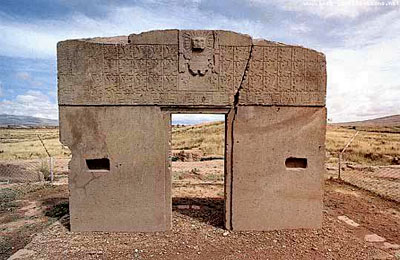



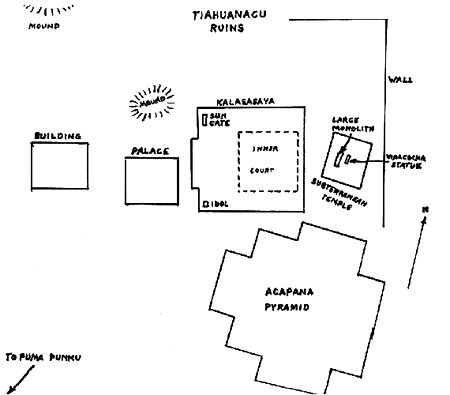



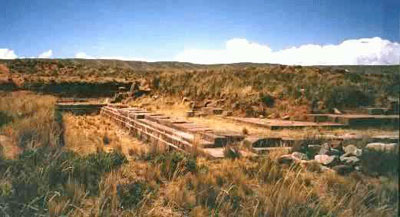
 As Boero Rojo stated, the discovery of Aymara structures under the waters of Lake Titicaca could pose entirely new thesis on the disappearance of an entire civilization, which, for some unknown reason, became submerged.
As Boero Rojo stated, the discovery of Aymara structures under the waters of Lake Titicaca could pose entirely new thesis on the disappearance of an entire civilization, which, for some unknown reason, became submerged. 











 The Iwo Eleru skull from Nigeria (on the right) dates to 13,000 years ago but shows more ancient features like those in the 140,000-year-old Laetoli skull (on the left).
The Iwo Eleru skull from Nigeria (on the right) dates to 13,000 years ago but shows more ancient features like those in the 140,000-year-old Laetoli skull (on the left). 

 Without question, a technically advanced, sophisticated civilization lived here on our coasts building very large, very complex harbors and canals. Many of the harbor systems are connected to a secondary tidal shoulder, close to a shoreline, but not to the existing shore, and have no current use, purpose or function. Many of the harbors appear to be between 6' and 9' underwater. Local evaluation will establish exact depths.
Without question, a technically advanced, sophisticated civilization lived here on our coasts building very large, very complex harbors and canals. Many of the harbor systems are connected to a secondary tidal shoulder, close to a shoreline, but not to the existing shore, and have no current use, purpose or function. Many of the harbors appear to be between 6' and 9' underwater. Local evaluation will establish exact depths. 





























 ,
, 
















































































































 Photograph © Justin Kerr
Photograph © Justin Kerr 





































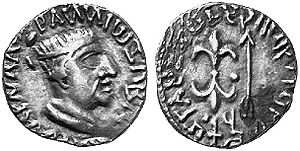


























































 Drawing by Alfred P. Maudslay - Quirigua, Guatemala 19th c.(Image of elephants in Maya sculpture, http://ldsarchaeology.blogspot.com/)
Drawing by Alfred P. Maudslay - Quirigua, Guatemala 19th c.(Image of elephants in Maya sculpture, http://ldsarchaeology.blogspot.com/) 






































 Photographs © Justin Kerr
Photographs © Justin Kerr 









































 Above are images portraying the Mexican god Tlaloc. On the left is an image taken from a mural at Teotihuacan that cleverly encodes a Venus symbol in Tlaloc's headdress. On the right is a large vessel or olla that depicts a fanged Tlaloc with Venus symbol encoded around his goggled eyes.
Above are images portraying the Mexican god Tlaloc. On the left is an image taken from a mural at Teotihuacan that cleverly encodes a Venus symbol in Tlaloc's headdress. On the right is a large vessel or olla that depicts a fanged Tlaloc with Venus symbol encoded around his goggled eyes. 

























































 The carved block from the Maya ruins of La Corona, portrays a seated Maya ruler wearing a Chac-Xib-Chac headdress and a royal chest pectoral depicting two Fleur-de-lis emblems. According to Maya scholar David Stuart, the glyphs on the above monument reveal the “end date” for the Mayan calendar, becoming only the second known document to do so.
The carved block from the Maya ruins of La Corona, portrays a seated Maya ruler wearing a Chac-Xib-Chac headdress and a royal chest pectoral depicting two Fleur-de-lis emblems. According to Maya scholar David Stuart, the glyphs on the above monument reveal the “end date” for the Mayan calendar, becoming only the second known document to do so. 







![[Triratna+symbols+BUDDHIST+page+125+fergusson+1910.jpg]](http://1.bp.blogspot.com/_WSQsPuiQ9Nc/SkCoIFai4WI/AAAAAAAABjo/rBG4ywGNnk8/s1600/Triratna%2Bsymbols%2BBUDDHIST%2Bpage%2B125%2Bfergusson%2B1910.jpg)



































































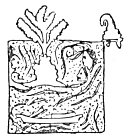


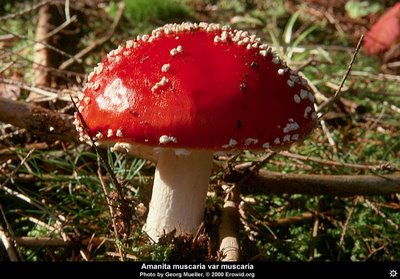

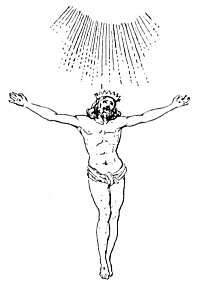
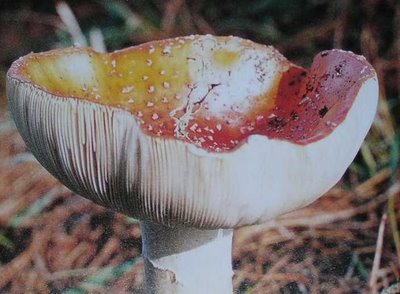




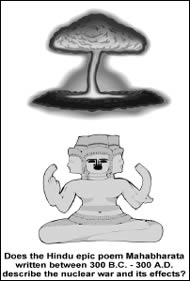 Since this is often reproduced together with notices of the downfall of the Indus civilization and subsequent warfare dated to 2500-3500 years ago, This vastly destructive War Of The Gods could be related to the timescale of Velikovsky's cosmic catastrophes and their chronology, and indeed Velikovsky has done exactly that.
Since this is often reproduced together with notices of the downfall of the Indus civilization and subsequent warfare dated to 2500-3500 years ago, This vastly destructive War Of The Gods could be related to the timescale of Velikovsky's cosmic catastrophes and their chronology, and indeed Velikovsky has done exactly that.









